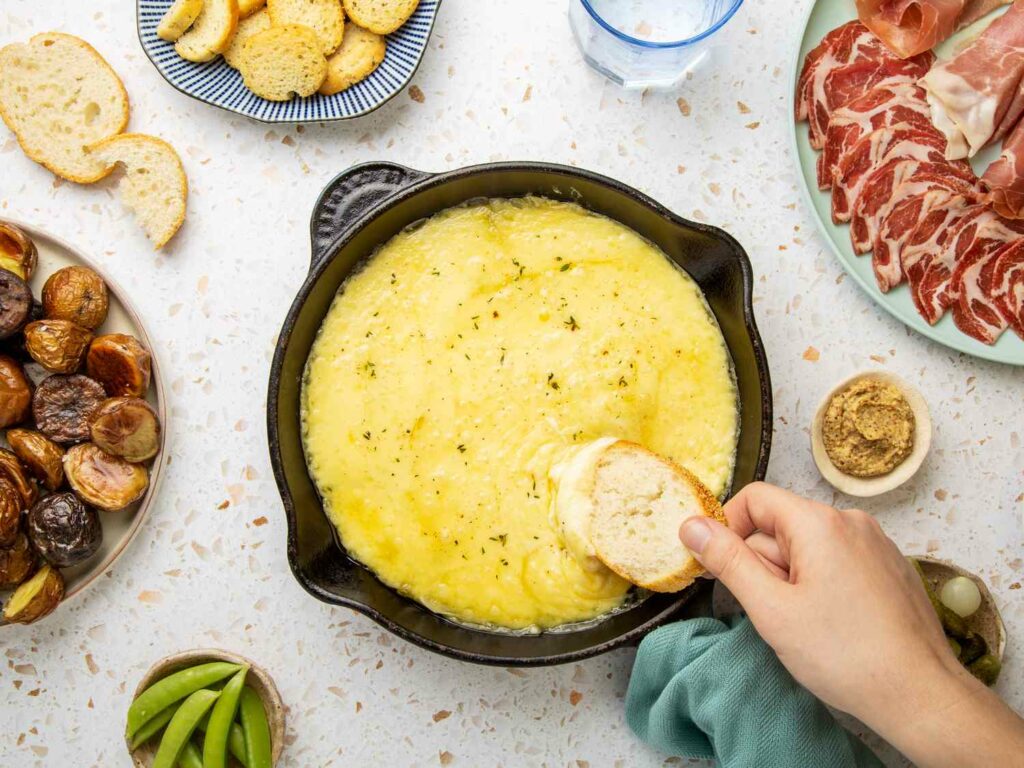Raclette: A Culinary Tradition of Alpine Delight

Introduction:
Nestled amidst the breathtaking landscapes of the Swiss and French Alps, there exists a culinary tradition that embodies the warmth and camaraderie of mountain life. Raclette, a decadent dish of melted cheese served with an array of accompaniments, has been cherished for centuries as a symbol of Alpine hospitality and conviviality. But beyond its delectable taste lies a fascinating history and a meticulously crafted recipe that reflects the spirit of Alpine cuisine. Join us as we embark on a journey to uncover the origins, traditions, and techniques behind this iconic dish.
Origins of Raclette: The origins of raclette can be traced back to the Alpine regions of Switzerland and France, where it emerged as a humble peasant dish in the Middle Ages. The word “raclette” is derived from the French word “racler,” which means “to scrape,” referring to the traditional method of melting cheese and scraping it onto a plate.
Originally, raclette was made by heating a wheel of cheese over an open fire, then scraping off the melted cheese onto boiled potatoes, bread, and other accompaniments. The dish was enjoyed by shepherds and farmers during the long winter months when fresh produce was scarce and hearty, warming meals were essential for survival.
Over time, raclette evolved into the rich and indulgent dish that we know today, with each region of the Alps putting its own unique spin on the classic recipe. Today, raclette holds a special place in Alpine culture, serving as a symbol of tradition, conviviality, and culinary excellence.
Ingredients and Preparation: While there are many variations of raclette, the classic recipe typically consists of the following ingredients:
- Cheese: The cheese used in raclette is typically a semi-firm, creamy cheese with a mild, nutty flavor that melts well. Traditional varieties of raclette cheese include Swiss Raclette, French Raclette, and Raclette de Savoie, although other cheeses such as Gruyère, Emmental, and Fontina may also be used.
- Accompaniments: Raclette is traditionally served with a variety of accompaniments, including boiled potatoes, cornichons (small pickles), pickled onions, cured meats such as charcuterie, and crusty bread. These accompaniments add texture and flavor to the dish, creating a satisfying and indulgent meal.
- Heating Source: Raclette is typically heated using a special raclette grill or machine, which consists of a heating element and individual trays or pans for melting the cheese. The cheese is placed in the trays and heated until melted and bubbly, then scraped onto the plates or directly onto the accompaniments.
Cultural Significance: Raclette holds a special place in Alpine culture, serving as a symbol of hospitality, friendship, and celebration. It is often enjoyed at festive gatherings and social events, where friends and family gather around the raclette grill to share a meal and create cherished memories together.
In addition to its cultural significance, raclette has also gained popularity around the world, with restaurants and cheese shops offering their own unique interpretations of the dish. It has even become a popular option for dinner parties and casual entertaining, providing a fun and interactive dining experience for guests of all ages.
Tips and Variations: While traditional raclette is made with cheese, potatoes, and pickles, there are many variations of the dish that incorporate different ingredients and flavors. Some popular variations include:
- Seafood Raclette: Made with a variety of seafood such as shrimp, scallops, and lobster, seafood raclette offers a luxurious twist on the classic dish that is perfect for special occasions.
- Vegetable Raclette: Made with grilled or roasted vegetables such as mushrooms, bell peppers, and zucchini, vegetable raclette offers a lighter and healthier alternative that is still packed with flavor.
- Dessert Raclette: Made with sweet accompaniments such as fresh fruit, chocolate, and marshmallows, dessert raclette is a fun and indulgent treat that is sure to satisfy any sweet tooth.
Conclusion: In conclusion, raclette is much more than just a dish—it’s a culinary experience that celebrates the warmth and conviviality of Alpine life. From its humble origins as a peasant meal to its status as a beloved symbol of hospitality and tradition, raclette continues to captivate and delight food lovers of all ages.
So whether you’re savoring it in a cozy mountain chalet or trying it for the first time in your own kitchen, one thing is for certain: raclette is a timeless classic that never fails to impress. So why not indulge in a taste of Alpine culture and experience the magic of raclette for yourself? Bon appétit!




